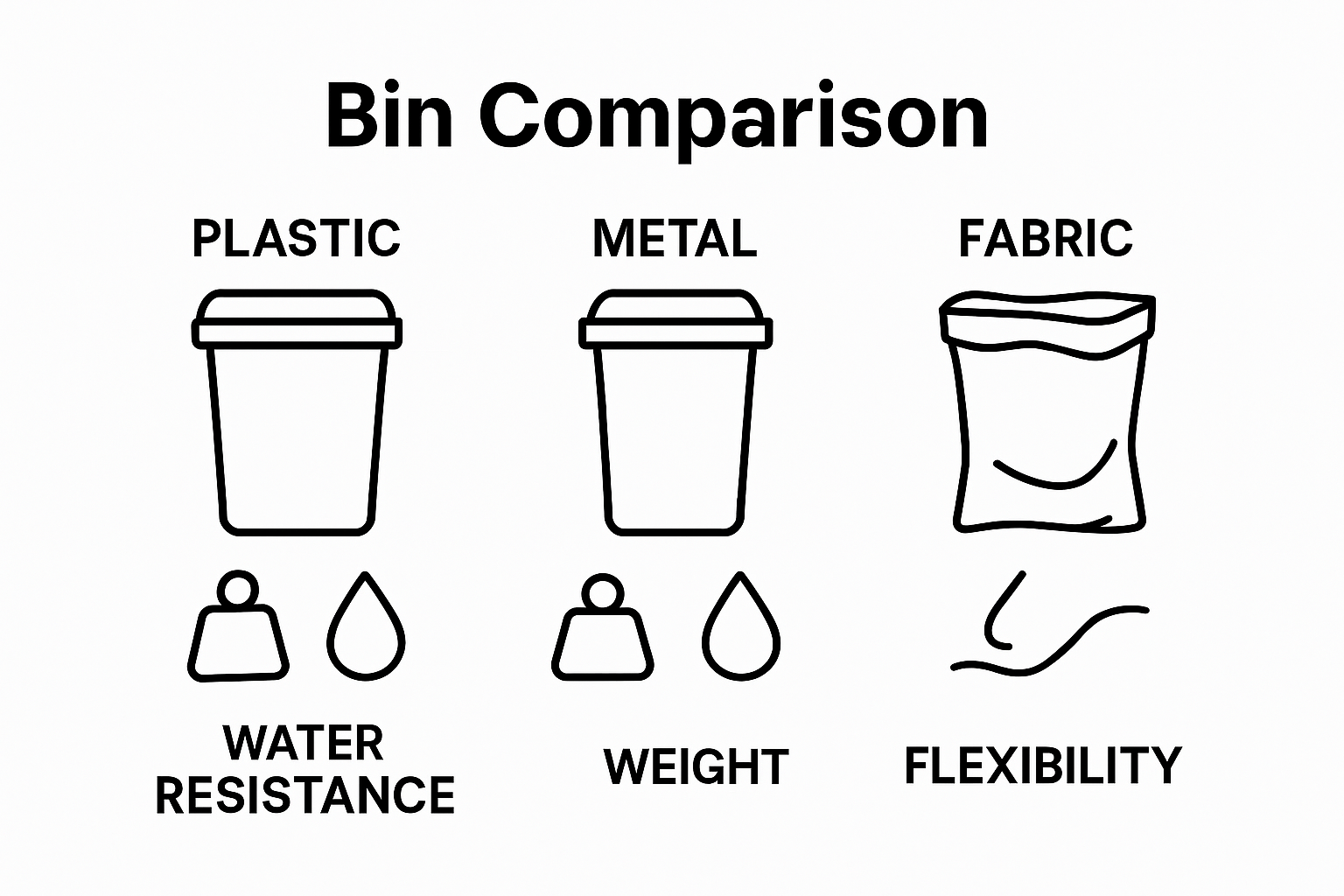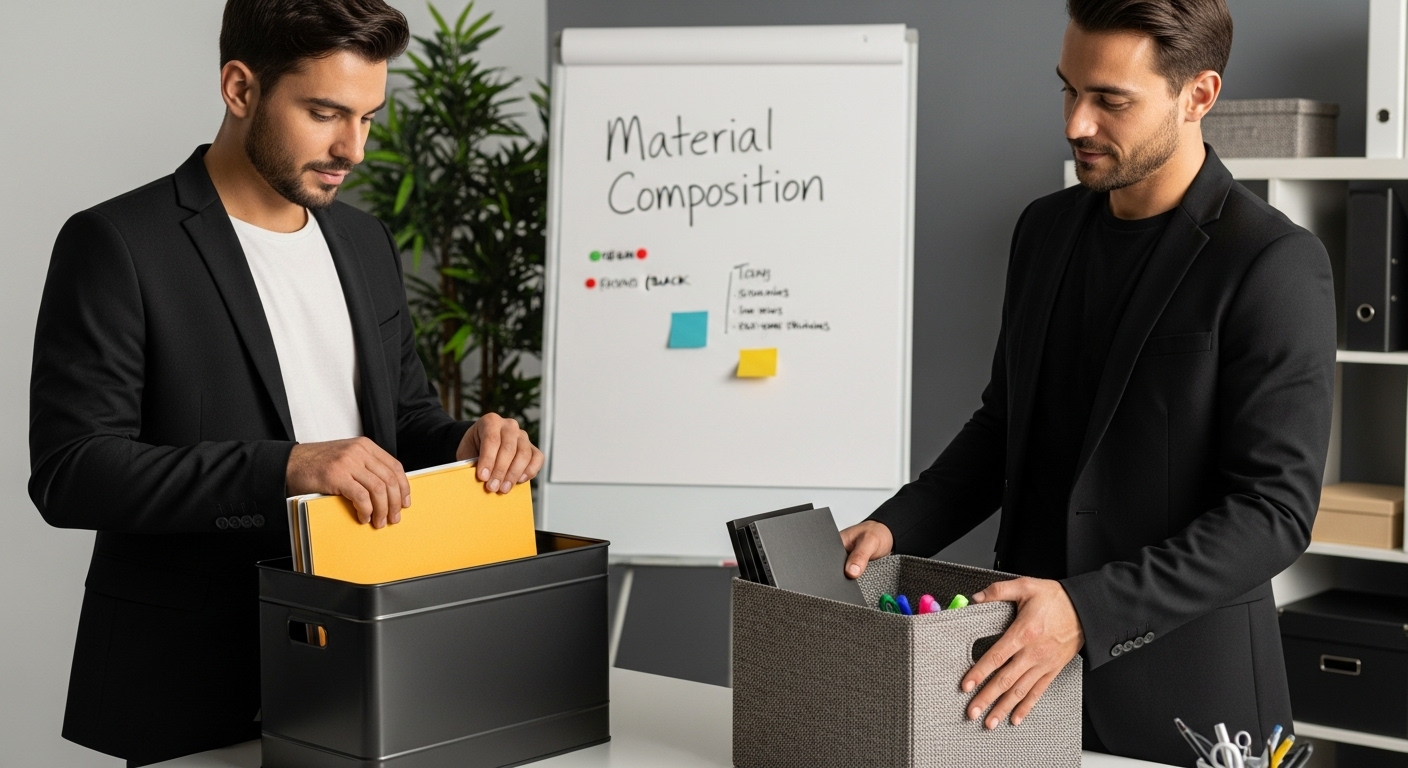
Everyone wants a neater space, and storage bins seem like the obvious answer for clutter. Yet the real surprise is how versatile these containers actually are. Some bins can improve inventory efficiency by as much as 40 percent in professional settings. The real power of a simple bin goes far beyond tidying up your closet.
Table of Contents
- What Are Storage Bins And Their Importance?
- Key Characteristics Of Different Storage Bin Types
- Practical Uses Of Various Storage Bins
- Choosing The Right Storage Bin For Your Needs
Quick Summary
| Takeaway | Explanation |
|---|---|
| Storage bins optimize organization and space | Effective use of storage bins helps reduce clutter and enhance space efficiency in homes and workplaces. |
| Choose bins based on material and function | Selecting the right material maximizes durability and functionality for specific storage needs. |
| Assess item characteristics before selection | Evaluate weight, access frequency, and environmental conditions to find suitable storage bins. |
| Specialized designs solve unique challenges | Different storage environments, like home or industrial, require bins with tailored features for optimal use. |
| Strategic bin placement enhances efficiency | Proper labeling and arrangement can streamline item retrieval and improve overall organizational effectiveness. |
What Are Storage Bins and Their Importance?
Storage bins represent essential organizational tools designed to collect, categorize, and preserve various items across home and professional environments. These versatile containers serve multiple functions beyond simple storage, offering practical solutions for managing personal belongings, workplace materials, and household goods.
Understanding Storage Bin Fundamentals
At their core, storage bins are specialized containers constructed from materials like plastic, metal, fabric, or wood. Their primary purpose centers on creating structured spaces that minimize clutter, protect items from environmental damage, and maximize spatial efficiency. Explore our comprehensive storage solutions to understand how these containers can transform your organizational strategies.
The University of Vermont Extension highlights critical design considerations for effective storage containers, emphasizing features such as:
- Durability for long-term use
- Easy cleaning capabilities
- Efficient handling characteristics
- Stackable or nestable configurations
Types and Applications of Storage Bins
Storage bins come in numerous variations tailored to specific needs. Household storage bins might include clear plastic containers for pantry organization, fabric bins for closet management, and specialized containers for garage or workshop environments. Professional settings utilize industrial-grade storage solutions for inventory management, while agricultural sectors employ large-scale storage bins for grain and produce preservation.
According to research from the ADM Institute for Prevention of Postharvest Loss, storage technologies range from traditional woven baskets to modern climate-controlled systems. This diversity underscores the critical role storage bins play in protecting valuable resources across multiple sectors.
By providing structured, protective spaces, storage bins help individuals and organizations maintain order, protect assets, and optimize available space. Whether managing household items, workplace materials, or agricultural products, these containers represent more than simple storage solutions they are strategic tools for efficiency and organization.
Key Characteristics of Different Storage Bin Types
Storage bins vary dramatically in design, material, and functionality, making them adaptable to numerous organizational needs. Understanding their distinctive characteristics helps individuals and professionals select the most appropriate containers for specific storage requirements.
Material Composition and Design
Storage bins are primarily constructed from materials that determine their durability, weight capacity, and potential applications.
 Learn about our versatile storage solutions that showcase diverse material options.
Learn about our versatile storage solutions that showcase diverse material options.
Materials commonly used in storage bin manufacturing include:
- Plastic: Lightweight, moisture-resistant, and affordable
- Metal: Highly durable, suitable for industrial settings
- Fabric: Flexible, collapsible, and aesthetically pleasing
- Wood: Traditional, robust, and often used in decorative storage solutions
According to research from the Material Handling Industry, these materials are selected based on specific performance requirements such as load-bearing capacity, environmental resistance, and intended usage context.
To help you compare the most common storage bin materials and understand their key qualities, the table below summarizes material composition and typical applications.
| Material | Durability | Weight | Typical Use Cases | Special Features |
|---|---|---|---|---|
| Plastic | Moderate-High | Lightweight | Pantry, closet, garage, office | Moisture-resistant, affordable |
| Metal | High | Heavy | Industrial, warehouse | High durability, stackable |
| Fabric | Moderate | Very Light | Closet, children’s rooms | Collapsible, visually appealing |
| Wood | High | Heavy | Decorative, traditional homes | Robus, decorative appeal |

Specialized Storage Bin Categories
Storage bins are not one-size-fits-all solutions. Different environments demand specialized designs that address unique organizational challenges. Agricultural storage bins, for instance, might prioritize moisture control and pest resistance, while home storage bins focus on aesthetic appeal and space optimization.
Industrial storage systems often incorporate advanced features like:
- Modular configurations for flexible arrangement
- Stackable designs to maximize vertical space
- Color-coded systems for quick inventory management
- Integrated labeling mechanisms for efficient tracking
The Food and Agriculture Organization highlights that specialized storage containers can significantly impact preservation quality, particularly in sectors like grain management where environmental control is critical.
By understanding these nuanced characteristics, users can select storage bins that not only solve immediate organizational needs but also provide long-term efficiency and protection for their valuable items.
Practical Uses of Various Storage Bins
Storage bins transcend simple organizational tools, serving critical functions across diverse environments from residential spaces to complex industrial settings. Their versatility enables efficient management of resources, protection of valuable items, and optimization of available space.
Residential and Personal Storage Applications
In home environments, storage bins play a transformative role in managing household items. Check out our specialized storage containers designed to streamline personal organization. These containers help individuals categorize and preserve items like:
- Seasonal clothing and accessories
- Holiday decorations
- Important documents and memorabilia
- Children’s toys and educational materials
- Spare linens and bedding
According to research from the Occupational Safety and Health Administration, proper storage strategies can significantly enhance organizational efficiency and reduce potential safety risks associated with cluttered living spaces.
Professional and Industrial Storage Solutions
Beyond residential use, storage bins are fundamental in professional environments. Industrial sectors leverage specialized containers for inventory management, product preservation, and workspace optimization.
Below is a quick reference table highlighting how residential and industrial storage bins differ across critical features, making it easier to determine which is best for your needs.
| Feature | Residential Bins | Industrial Bins |
|---|---|---|
| Design Focus | Aesthetic appeal, space-saving | Durability, standardization |
| Typical Material | Plastic, fabric, wood | Metal, heavy-duty plastic |
| Common Use | Home, office, closets, personal | Warehouse, manufacturing, logistics |
| Flexibility | Collapsible, lightweight | Modular, stackable |
| Labeling/Tracking | Minimal or color-coded | Integrated labeling, inventory tags |
| Frequency of Use | Occasional to frequent | Frequent, high-traffic |
| Specialized Features | Visual appeal, ease of access | Advanced modularity, load capacity |
Industrial storage bin applications include:
- Warehouse inventory tracking
- Laboratory sample management
- Manufacturing parts organization
- Pharmaceutical supply storage
- Agricultural produce preservation
The University of Vermont Extension emphasizes that well-designed storage containers can reduce safety risks and enhance operational efficiency by providing durable, cleanable, and strategically organized storage solutions.
By understanding the multifaceted applications of storage bins, individuals and organizations can select purpose-specific containers that not only solve immediate storage challenges but also contribute to long-term organizational effectiveness and resource protection.
Choosing the Right Storage Bin for Your Needs
Selecting the appropriate storage bin requires careful consideration of multiple factors to ensure optimal organization, protection, and efficiency. Understanding how to match storage solutions with specific requirements can dramatically improve space management and item preservation.
Assessing Your Storage Requirements
Before purchasing storage bins, evaluate the unique characteristics of items you intend to store. Explore our range of customized storage solutions designed to meet diverse organizational needs.
Key considerations when selecting storage bins include:
- Weight and volume of stored items
- Environmental conditions (humidity, temperature)
- Frequency of item access
- Available storage space
- Aesthetic preferences
According to research from Yale University’s Sustainability Office, proper bin selection involves understanding usage patterns and creating intuitive storage systems.
Matching Bin Features to Specific Needs
Different storage scenarios demand specialized bin characteristics. Home organization requires flexible, visually appealing containers, while industrial settings prioritize durability and standardization.
Consider these strategic selection criteria:
- Transparent bins for easy visual inventory
- Stackable designs to maximize vertical space
- Sealed containers for moisture-sensitive items
- Color-coded systems for quick categorization
- Ergonomic handles for convenient transportation
The University of Massachusetts Amherst recommends maximizing cubic storage space through strategic bin placement and consistent organizational principles. Proper labeling and systematic arrangement can significantly reduce retrieval time and enhance overall efficiency.
By thoughtfully evaluating your specific storage requirements and matching them with appropriate bin features, you can create a highly functional and streamlined organizational system that protects and preserves your valuable items.
Find Your Perfect Storage Bin Type for Every Space
Struggling to keep your home clutter-free despite your best efforts? Our article explains how different storage bin types can make organization simpler and more effective. Many readers feel overwhelmed by clutter in bathrooms, garages, and closets because they cannot find the right solution for specific needs or spaces. Choosing the right container is essential for protecting your belongings and optimizing every inch of your home.
Explore our Bathroom Storage collection to see how our bins are designed for tight spaces, moisture resistance, and frequent access.

Ready to transform your home? Visit BLUSHBEES USA for solutions that go beyond the basics. Or check our Garage Storage options if you want to take control of your tools and seasonal gear. Organization becomes fast and stress-free when you choose the right storage bin today.
Frequently Asked Questions
What are the primary materials used in storage bins?
Storage bins are commonly made from materials such as plastic, metal, fabric, and wood. Each material offers different benefits in terms of durability, weight capacity, and aesthetic appeal.
How can I determine the right storage bin for my needs?
To select the right storage bin, assess the weight and volume of the items you plan to store, the environmental conditions, how frequently you access the items, and your aesthetic preferences. It’s important to match bin features with your specific storage requirements.
What are the differences between residential and industrial storage bins?
Residential storage bins tend to focus on aesthetic appeal and space optimization, often being lightweight and flexible, while industrial storage bins are designed for durability and standardization, often featuring modular configurations for efficient inventory management.
How do specialized storage bins differ from general-purpose bins?
Specialized storage bins are designed for specific applications, such as moisture control in agricultural settings or stackable designs for maximizing small spaces. In contrast, general-purpose bins lack these specialized features and may not address unique storage challenges effectively.
Recommended
- Blushbees® 3-Pack Large Capacity Storage Bins - Sturdy Foldable Boxes – BLUSHBEES USA
- Maximize Space and Declutter with Collapsible Storage Boxes: The Ultim – BLUSHBEES USA
- Blushbees under the Bed Storage Containers 6 Inch High. – BLUSHBEES USA
- Top Under Bed Storage Hacks for Stylish Homes in 2025 – BLUSHBEES USA
- How to Pack a Storage Container for Maximum Efficiency



